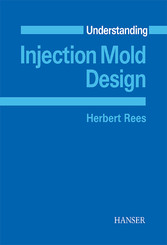Herbert Rees
Understanding Injection Mold Design
Introduction to the Series
6
Preface
8
Contents
10
1 Introduction
14
1.1 Economics of Mold Design
16
2 Starting New in the Mold Design Field
18
3 The Basics of an Injection Molding Machine
20
4 Understanding the Basics of the Injection Mold
22
4.1 Design Rules
22
4.2 The Basic Mold
22
4.2.1 Mold Cavity Space
22
4.2.2 Number of Cavities
23
4.2.3 Cavity Shape and Shrinkage
24
4.3 Cavity and Core
24
4.4 The Parting Line
25
4.4.1 Split Molds and Side Cores
26
4.5 Runners and Gates
27
4.6 Projected Area and Injection Pressure
28
4.6.1 Clamping Force
29
4.6.2 Strength of the Mold
29
4.6.3 Why Are High Injection Pressures Needed?
30
4.7 Venting
31
4.8 Cooling
31
4.8.1 Basics of Cooling
32
4.8.2 Plate Cooling
35
4.9 Ejection
35
4.9.1 Automatic Molding
38
4.10 Shrinkage
39
4.10.1 Variable Shrinkage
39
4.11 Alignment
40
4.11.1 No Provision for Alignment
40
4.11.2 Leader Pins and Bushings
41
4.11.3 Taper Lock Between Each Cavity and Core
42
4.11.4 Taper Locks and Wedges
43
4.11.5 Taper Pins
44
4.11.6 Too Many Alignment Features
44
5 Before Starting to Design a Mold
46
5.1 Information and Documentation
46
5.1.1 Is the Product Design Ready?
46
5.1.2 Are the Tolerances Shown?
46
5.1.3 Are the Tolerances Reasonable?
47
5.1.4 What are the Cycle Times?
47
5.1.5 What is the Expected Production?
47
5.1.6 What are the Machine Specifications?
48
5.2 Start of Mold Design
55
5.2.1 Mold Shoes
55
5.2.2 Mold Drawings
58
5.2.3 The Stack Layout
61
5.2.4 Selection of a Suitable Runner System
69
5.2.5 Venting
78
5.2.6 Ejection
81
5.2.7 Cooling
82
5.2.8 Alignment of Stack
86
5.2.9 Design Review
86
5.3 Preload
86
5.4 Mold Materials Selection
87
5.4.1 Effect of Expected Production
88
5.4.2 Forces in Molds
88
5.4.3 Characteristics of Steels and Other Mold Materials
88
5.5 Stack Molds
91
5.6 Mold Layout and Assembly Drawings
92
5.6.1 Machine Platen Layout
92
5.6.2 Symmetry of Layout, Balancing of Clamp
92
5.6.3 The Views
93
5.6.4 Completing the Assembly Drawing
93
5.6.5 Bill of Materials (BoM) and "Ballooning"
94
5.6.6 Finishing Touches
94
6 Review and Follow-Up
95
7 Typical Examples
96
7.1 Containers or Other Cup-Shaped Products
96
7.2 Technical Products
100
7.3 Mold with Fixed Cores
101
7.4 Mold with Floating Cores
102
7.5 Molds with Side Cores or Splits
103
8 Estimating Mold Cost
105
8.1 Need for Estimate
105
8.2 Precedents
106
8.3 No Precedents
106
8.4 Methods of Estimating
107
8.5 Mold Cost and Mold Price
108
9 Machining, Mold Materials, and Heat Treatment
110
9.1 Machining of Mold Components
110
9.2 Materials Selection
114
9.2.1 Steel Properties
115
9.3 Heat Treatment
119
Appendix 1 CAD/CAM (Computer- Assisted Design-Computer- Assisted Manufacturing)
121
Index
124
© 2009-2024 ciando GmbH
 Zu Hanser-Fachbuch.de
Zu Hanser-Fachbuch.de
 Warenkorb
Warenkorb
